Business Presentation on Social Sustainability Regulation and Practice
VerifiedAdded on 2023/05/28
|8
|982
|374
Presentation
AI Summary
This presentation delves into the critical aspects of social sustainability regulation and practice, particularly focusing on companies from developed countries that outsource manufacturing to factories in developing nations. It addresses key issues such as child labor, gender inequality, and the treatment of marginalized groups, drawing insights from the case study 'Third-world families at work: Child labor or child care?'. The presentation emphasizes the importance of multinational companies adhering to ethical standards, respecting local laws and customs, and investing in reforms that promote economic development and social justice. It also evaluates the credibility of sources using the CRAP method (Currency, Reliability, Authority, and Purpose) to ensure the information presented is accurate and unbiased, highlighting the need for responsible sourcing policies and practices in the global supply chain.
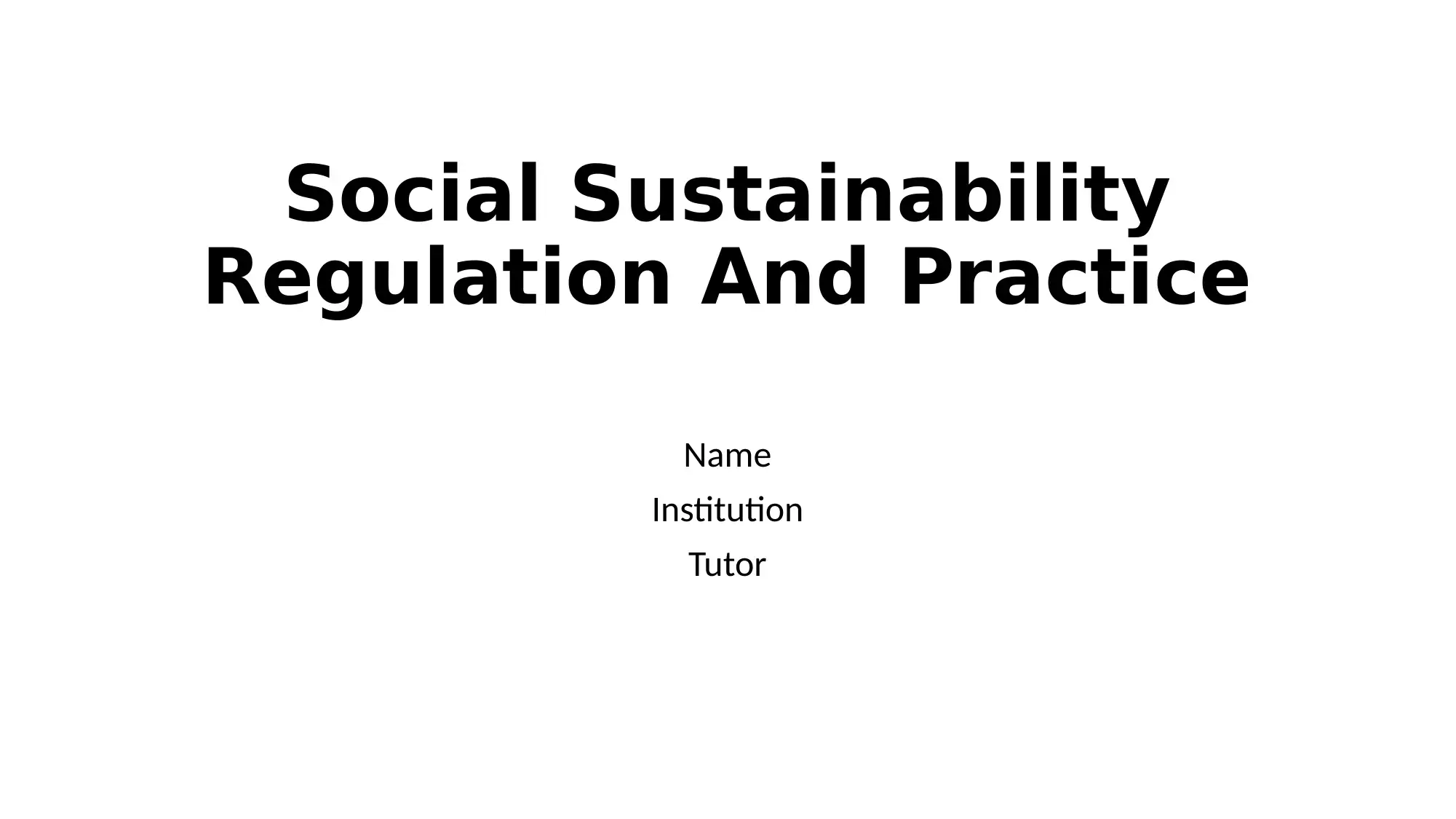
Social Sustainability
Regulation And Practice
Name
Institution
Tutor
Regulation And Practice
Name
Institution
Tutor
Paraphrase This Document
Need a fresh take? Get an instant paraphrase of this document with our AI Paraphraser
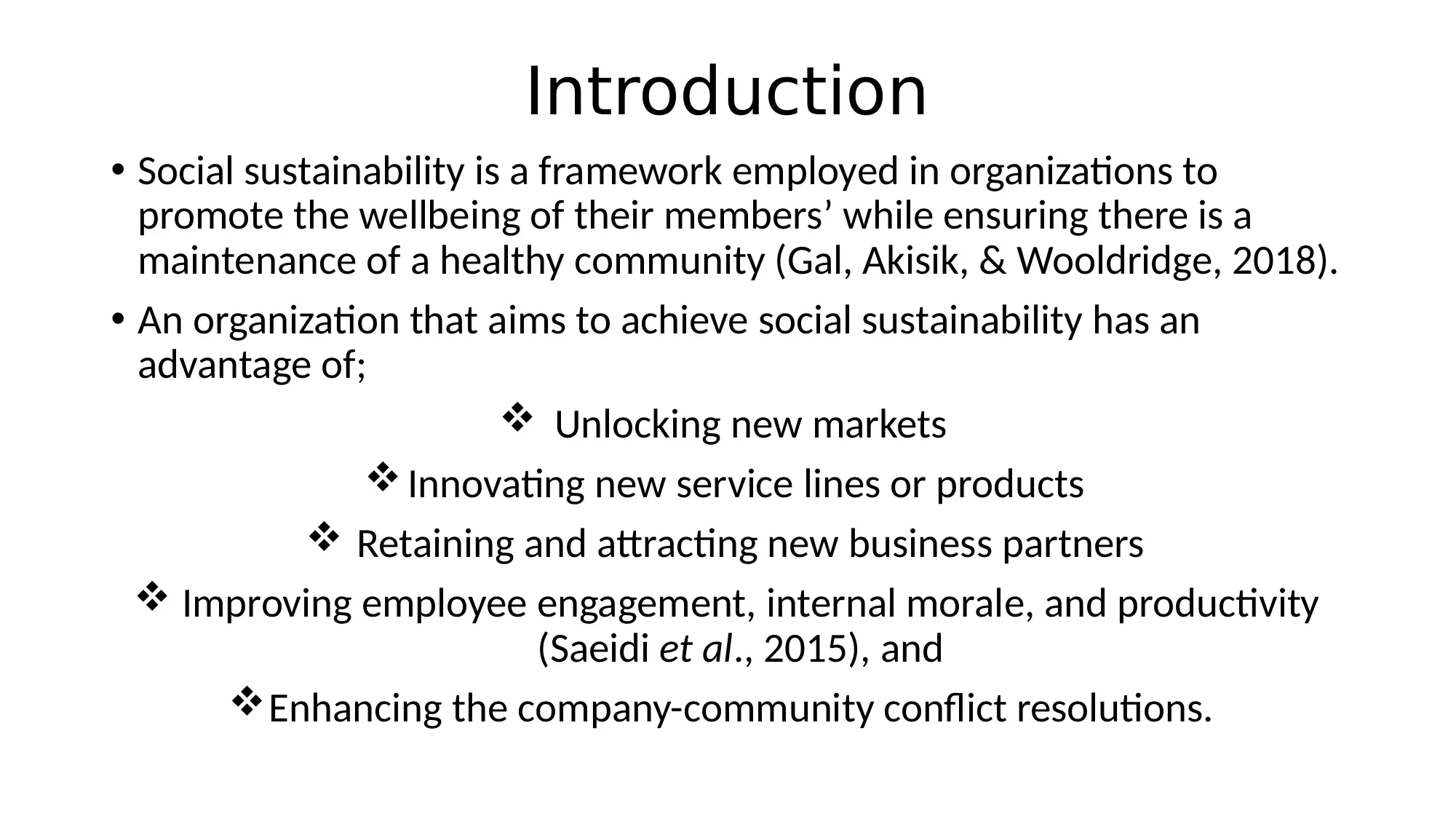
Introduction
• Social sustainability is a framework employed in organizations to
promote the wellbeing of their members’ while ensuring there is a
maintenance of a healthy community (Gal, Akisik, & Wooldridge, 2018).
• An organization that aims to achieve social sustainability has an
advantage of;
Unlocking new markets
Innovating new service lines or products
Retaining and attracting new business partners
Improving employee engagement, internal morale, and productivity
(Saeidi et al., 2015), and
Enhancing the company-community conflict resolutions.
• Social sustainability is a framework employed in organizations to
promote the wellbeing of their members’ while ensuring there is a
maintenance of a healthy community (Gal, Akisik, & Wooldridge, 2018).
• An organization that aims to achieve social sustainability has an
advantage of;
Unlocking new markets
Innovating new service lines or products
Retaining and attracting new business partners
Improving employee engagement, internal morale, and productivity
(Saeidi et al., 2015), and
Enhancing the company-community conflict resolutions.
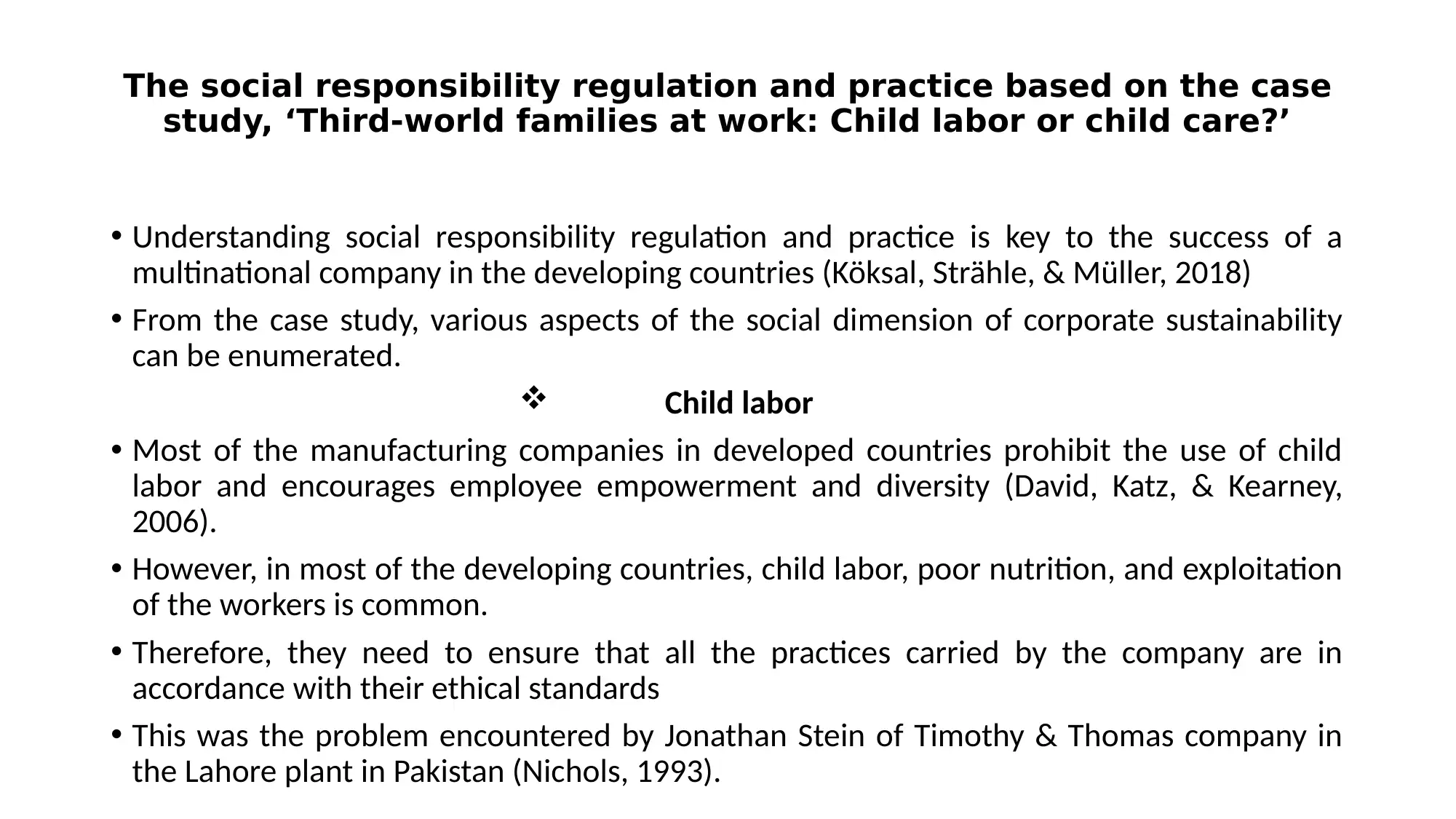
The social responsibility regulation and practice based on the case
study, ‘Third-world families at work: Child labor or child care?’
• Understanding social responsibility regulation and practice is key to the success of a
multinational company in the developing countries (Köksal, Strähle, & Müller, 2018)
• From the case study, various aspects of the social dimension of corporate sustainability
can be enumerated.
Child labor
• Most of the manufacturing companies in developed countries prohibit the use of child
labor and encourages employee empowerment and diversity (David, Katz, & Kearney,
2006).
• However, in most of the developing countries, child labor, poor nutrition, and exploitation
of the workers is common.
• Therefore, they need to ensure that all the practices carried by the company are in
accordance with their ethical standards
• This was the problem encountered by Jonathan Stein of Timothy & Thomas company in
the Lahore plant in Pakistan (Nichols, 1993).
study, ‘Third-world families at work: Child labor or child care?’
• Understanding social responsibility regulation and practice is key to the success of a
multinational company in the developing countries (Köksal, Strähle, & Müller, 2018)
• From the case study, various aspects of the social dimension of corporate sustainability
can be enumerated.
Child labor
• Most of the manufacturing companies in developed countries prohibit the use of child
labor and encourages employee empowerment and diversity (David, Katz, & Kearney,
2006).
• However, in most of the developing countries, child labor, poor nutrition, and exploitation
of the workers is common.
• Therefore, they need to ensure that all the practices carried by the company are in
accordance with their ethical standards
• This was the problem encountered by Jonathan Stein of Timothy & Thomas company in
the Lahore plant in Pakistan (Nichols, 1993).
⊘ This is a preview!⊘
Do you want full access?
Subscribe today to unlock all pages.

Trusted by 1+ million students worldwide
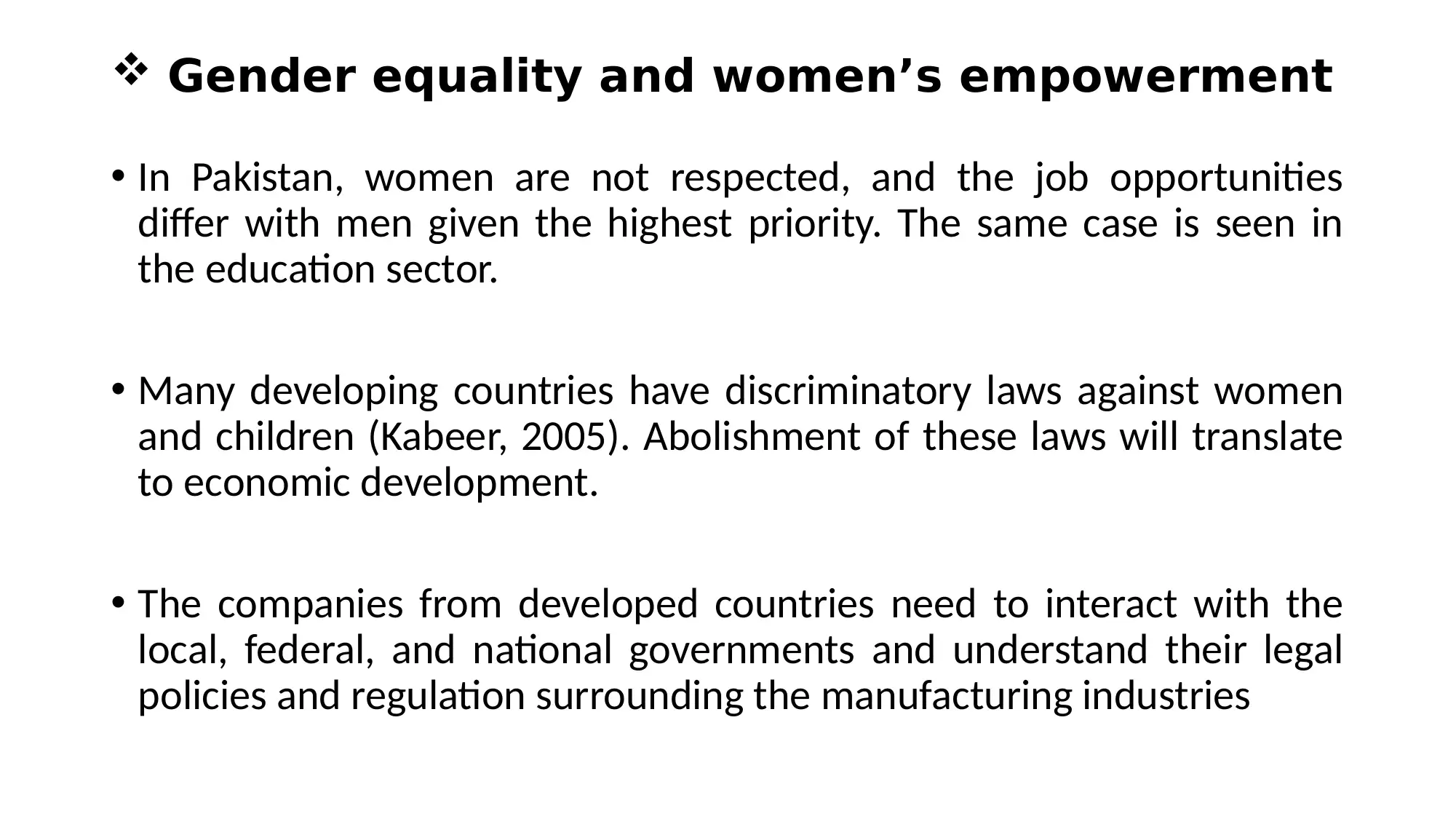
Gender equality and women’s empowerment
• In Pakistan, women are not respected, and the job opportunities
differ with men given the highest priority. The same case is seen in
the education sector.
• Many developing countries have discriminatory laws against women
and children (Kabeer, 2005). Abolishment of these laws will translate
to economic development.
• The companies from developed countries need to interact with the
local, federal, and national governments and understand their legal
policies and regulation surrounding the manufacturing industries
• In Pakistan, women are not respected, and the job opportunities
differ with men given the highest priority. The same case is seen in
the education sector.
• Many developing countries have discriminatory laws against women
and children (Kabeer, 2005). Abolishment of these laws will translate
to economic development.
• The companies from developed countries need to interact with the
local, federal, and national governments and understand their legal
policies and regulation surrounding the manufacturing industries
Paraphrase This Document
Need a fresh take? Get an instant paraphrase of this document with our AI Paraphraser
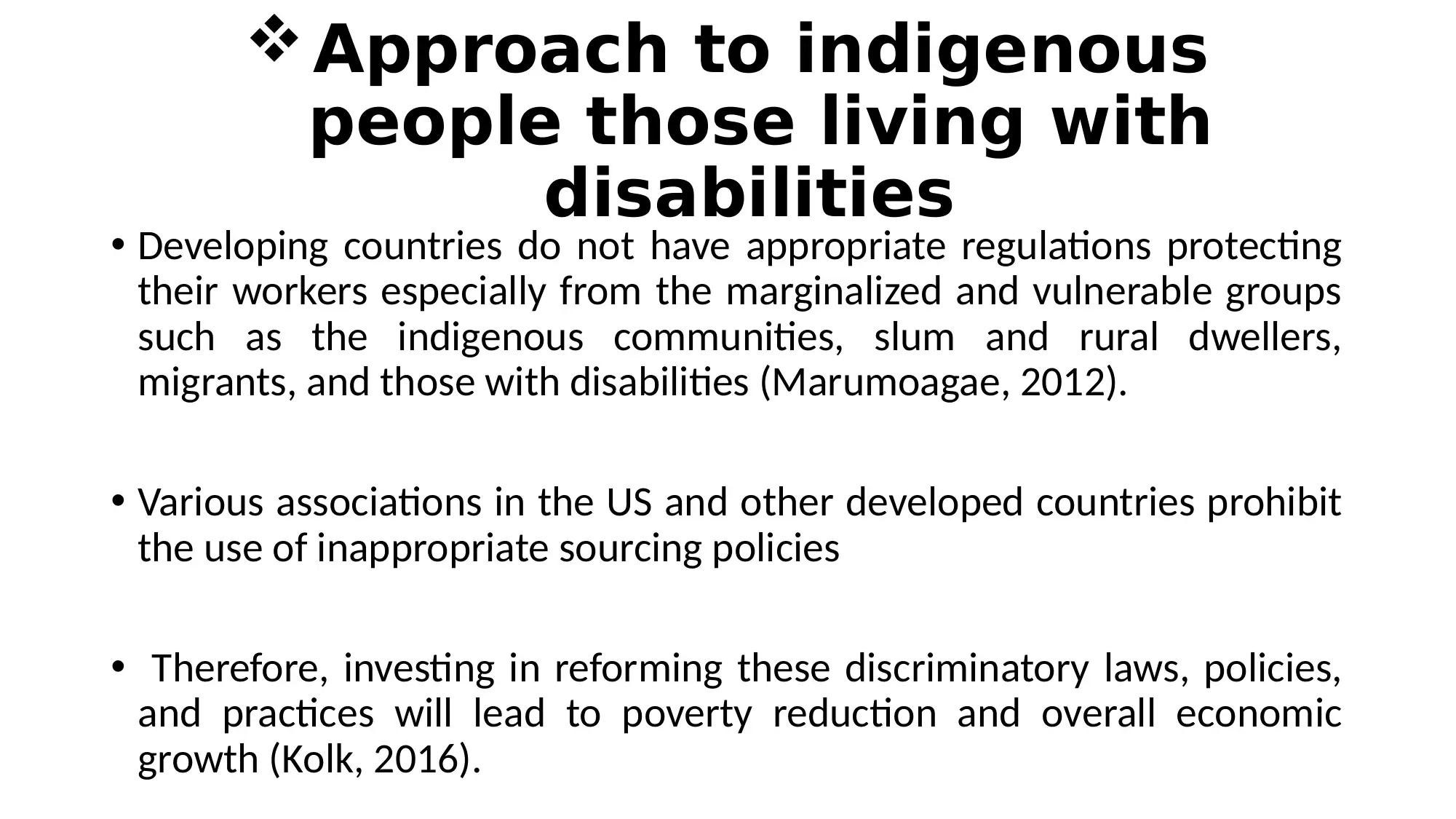
Approach to indigenous
people those living with
disabilities
• Developing countries do not have appropriate regulations protecting
their workers especially from the marginalized and vulnerable groups
such as the indigenous communities, slum and rural dwellers,
migrants, and those with disabilities (Marumoagae, 2012).
• Various associations in the US and other developed countries prohibit
the use of inappropriate sourcing policies
• Therefore, investing in reforming these discriminatory laws, policies,
and practices will lead to poverty reduction and overall economic
growth (Kolk, 2016).
people those living with
disabilities
• Developing countries do not have appropriate regulations protecting
their workers especially from the marginalized and vulnerable groups
such as the indigenous communities, slum and rural dwellers,
migrants, and those with disabilities (Marumoagae, 2012).
• Various associations in the US and other developed countries prohibit
the use of inappropriate sourcing policies
• Therefore, investing in reforming these discriminatory laws, policies,
and practices will lead to poverty reduction and overall economic
growth (Kolk, 2016).
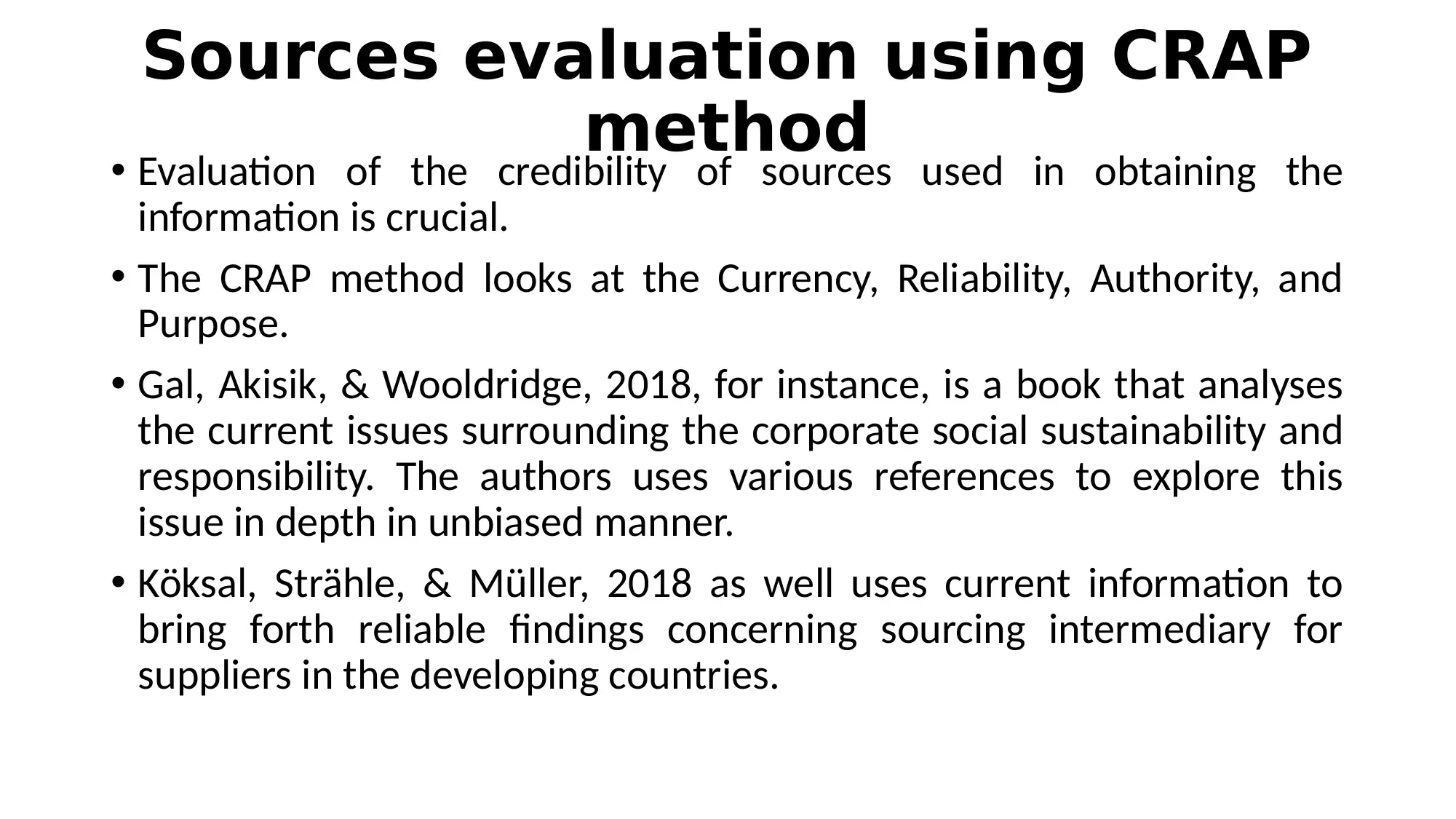
Sources evaluation using CRAP
method• Evaluation of the credibility of sources used in obtaining the
information is crucial.
• The CRAP method looks at the Currency, Reliability, Authority, and
Purpose.
• Gal, Akisik, & Wooldridge, 2018, for instance, is a book that analyses
the current issues surrounding the corporate social sustainability and
responsibility. The authors uses various references to explore this
issue in depth in unbiased manner.
• Köksal, Strähle, & Müller, 2018 as well uses current information to
bring forth reliable findings concerning sourcing intermediary for
suppliers in the developing countries.
method• Evaluation of the credibility of sources used in obtaining the
information is crucial.
• The CRAP method looks at the Currency, Reliability, Authority, and
Purpose.
• Gal, Akisik, & Wooldridge, 2018, for instance, is a book that analyses
the current issues surrounding the corporate social sustainability and
responsibility. The authors uses various references to explore this
issue in depth in unbiased manner.
• Köksal, Strähle, & Müller, 2018 as well uses current information to
bring forth reliable findings concerning sourcing intermediary for
suppliers in the developing countries.
⊘ This is a preview!⊘
Do you want full access?
Subscribe today to unlock all pages.

Trusted by 1+ million students worldwide
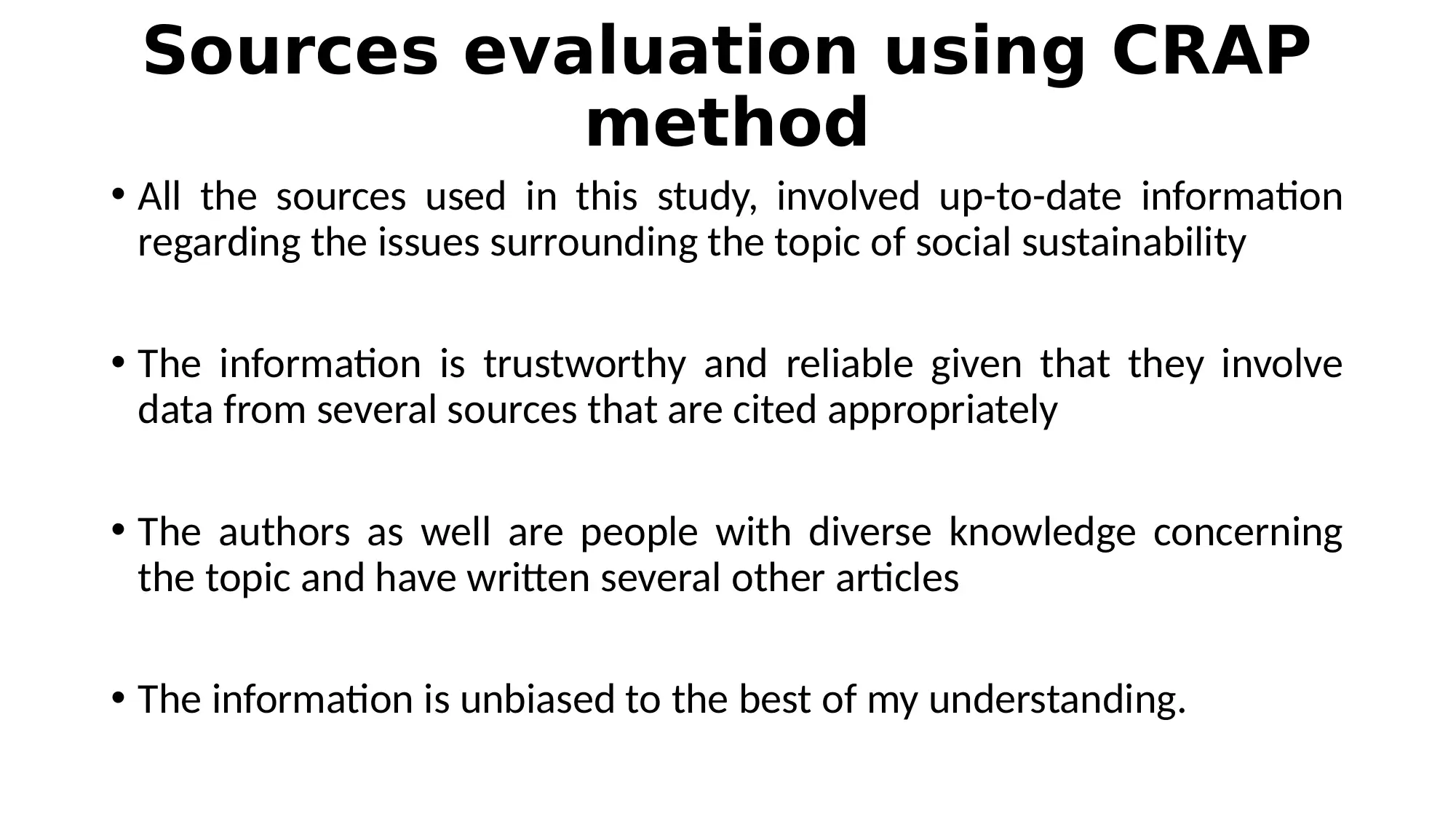
Sources evaluation using CRAP
method
• All the sources used in this study, involved up-to-date information
regarding the issues surrounding the topic of social sustainability
• The information is trustworthy and reliable given that they involve
data from several sources that are cited appropriately
• The authors as well are people with diverse knowledge concerning
the topic and have written several other articles
• The information is unbiased to the best of my understanding.
method
• All the sources used in this study, involved up-to-date information
regarding the issues surrounding the topic of social sustainability
• The information is trustworthy and reliable given that they involve
data from several sources that are cited appropriately
• The authors as well are people with diverse knowledge concerning
the topic and have written several other articles
• The information is unbiased to the best of my understanding.
Paraphrase This Document
Need a fresh take? Get an instant paraphrase of this document with our AI Paraphraser
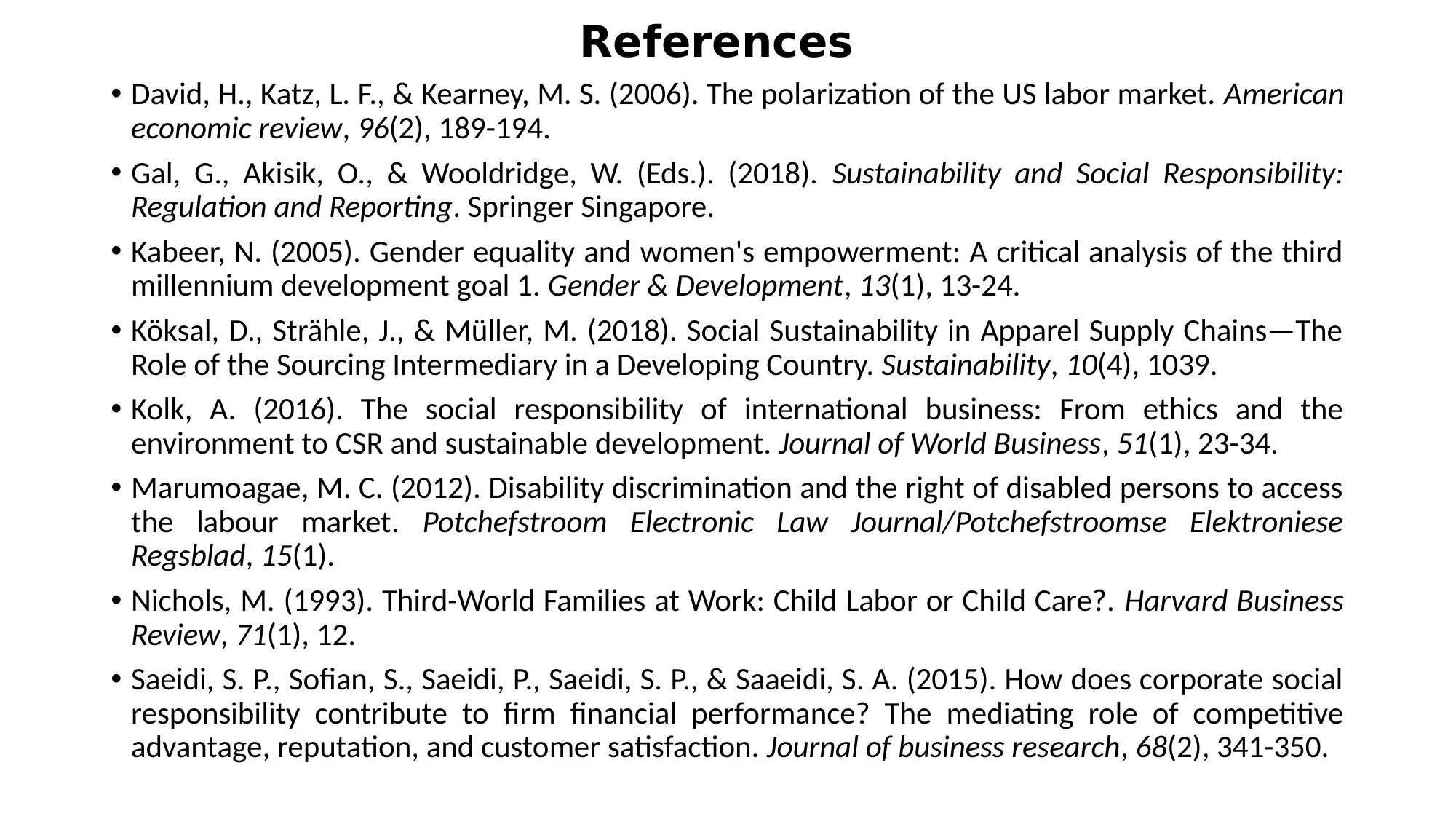
References
• David, H., Katz, L. F., & Kearney, M. S. (2006). The polarization of the US labor market. American
economic review, 96(2), 189-194.
• Gal, G., Akisik, O., & Wooldridge, W. (Eds.). (2018). Sustainability and Social Responsibility:
Regulation and Reporting. Springer Singapore.
• Kabeer, N. (2005). Gender equality and women's empowerment: A critical analysis of the third
millennium development goal 1. Gender & Development, 13(1), 13-24.
• Köksal, D., Strähle, J., & Müller, M. (2018). Social Sustainability in Apparel Supply Chains—The
Role of the Sourcing Intermediary in a Developing Country. Sustainability, 10(4), 1039.
• Kolk, A. (2016). The social responsibility of international business: From ethics and the
environment to CSR and sustainable development. Journal of World Business, 51(1), 23-34.
• Marumoagae, M. C. (2012). Disability discrimination and the right of disabled persons to access
the labour market. Potchefstroom Electronic Law Journal/Potchefstroomse Elektroniese
Regsblad, 15(1).
• Nichols, M. (1993). Third-World Families at Work: Child Labor or Child Care?. Harvard Business
Review, 71(1), 12.
• Saeidi, S. P., Sofian, S., Saeidi, P., Saeidi, S. P., & Saaeidi, S. A. (2015). How does corporate social
responsibility contribute to firm financial performance? The mediating role of competitive
advantage, reputation, and customer satisfaction. Journal of business research, 68(2), 341-350.
• David, H., Katz, L. F., & Kearney, M. S. (2006). The polarization of the US labor market. American
economic review, 96(2), 189-194.
• Gal, G., Akisik, O., & Wooldridge, W. (Eds.). (2018). Sustainability and Social Responsibility:
Regulation and Reporting. Springer Singapore.
• Kabeer, N. (2005). Gender equality and women's empowerment: A critical analysis of the third
millennium development goal 1. Gender & Development, 13(1), 13-24.
• Köksal, D., Strähle, J., & Müller, M. (2018). Social Sustainability in Apparel Supply Chains—The
Role of the Sourcing Intermediary in a Developing Country. Sustainability, 10(4), 1039.
• Kolk, A. (2016). The social responsibility of international business: From ethics and the
environment to CSR and sustainable development. Journal of World Business, 51(1), 23-34.
• Marumoagae, M. C. (2012). Disability discrimination and the right of disabled persons to access
the labour market. Potchefstroom Electronic Law Journal/Potchefstroomse Elektroniese
Regsblad, 15(1).
• Nichols, M. (1993). Third-World Families at Work: Child Labor or Child Care?. Harvard Business
Review, 71(1), 12.
• Saeidi, S. P., Sofian, S., Saeidi, P., Saeidi, S. P., & Saaeidi, S. A. (2015). How does corporate social
responsibility contribute to firm financial performance? The mediating role of competitive
advantage, reputation, and customer satisfaction. Journal of business research, 68(2), 341-350.
1 out of 8
Related Documents
Your All-in-One AI-Powered Toolkit for Academic Success.
+13062052269
info@desklib.com
Available 24*7 on WhatsApp / Email
![[object Object]](/_next/static/media/star-bottom.7253800d.svg)
Unlock your academic potential
Copyright © 2020–2025 A2Z Services. All Rights Reserved. Developed and managed by ZUCOL.





